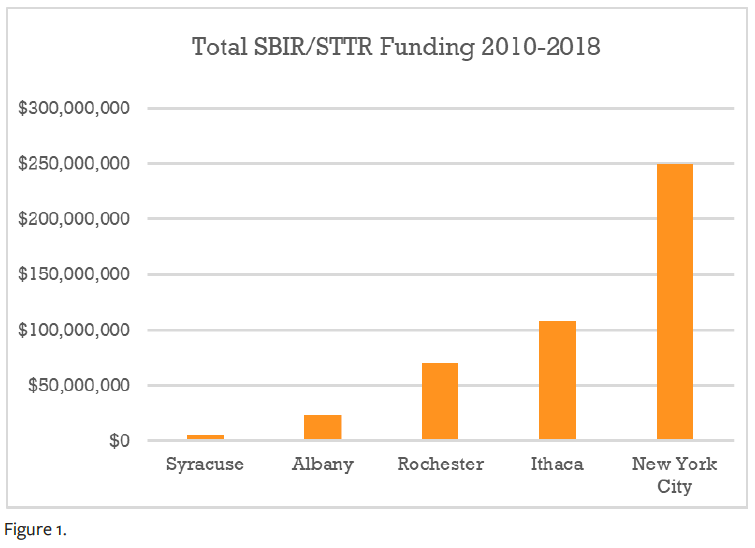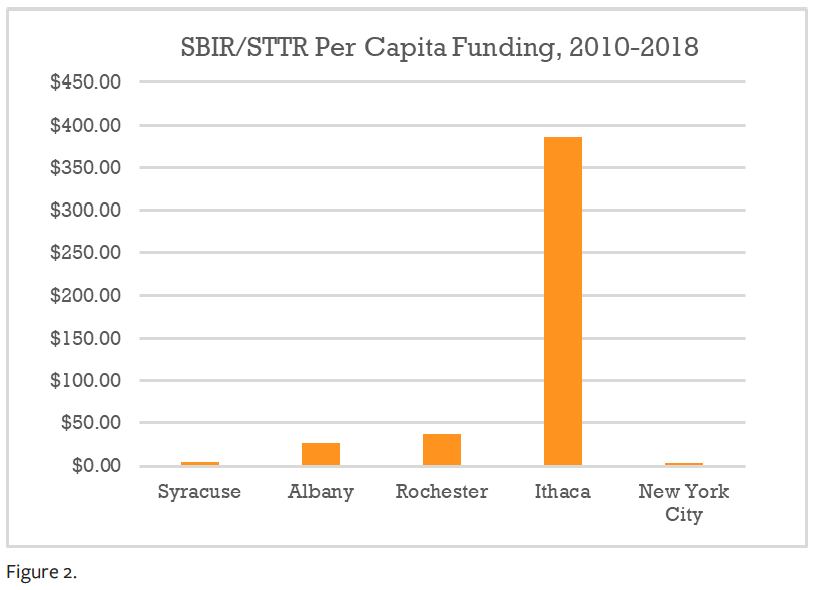Ithaca Beats Other New York Cities in Winning Federal Grants for STEM Startup Commercialization
Overview
Among the metropolitan areas in Upstate New York, Ithaca had the highest concentration of federal grants awarded to start-ups and small companies in the STEM space in 2018.
Punching Above Its Weight
From 2010-2018, Ithaca-based start-ups received 11% of all Small Business Innovation Research (SBIR) and Small Business Technology Transfer (STTR) funding awarded in New York State, totalling nearly $108 million in early-stage start-up investment by the federal government (see Fig.1).

Ithaca won more SBIR funding than any other upstate NY metro area, and even beat out New York City when controlling for population size (see Fig.2). It’s a trend that has been observed nationwide, according to the Brookings Institution. This summer, they reported that smaller metro areas with populations between 50,000 and 500,000 receive 16% more funding per 1,000 workers than the largest 100 metro areas. A trend the Brookings authors attributed to college towns like Ithaca.
Ithaca has a population of about 31,000 in 2017, the smallest of the other metropolitan area in Upstate New York. Calculating per capita award recipients, the dollar amounts of SBIR/STTR awards that went to Ithaca entrepreneurs outstripped all other metro areas. On average, Ithaca received $386.19 per capita in SBIR/STTR funding from 2010-2018, while New York City received just $3.21.

Federal grants are lifeblood to innovation. They are a smaller share of the funds that flow into tech start-ups, compared to private-sector research and development funding, but federal grants are more likely to fund early-stage ideas that are further away from commercialization. Some studies have linked increased federal funding of general science to increased private sector productivity, which then increases economic output, according to the Congressional Budget Office.
Stimulating Economic Development in STEM
Award recipients from Ithaca belong to diverse industries. A few examples include:
- Architecture Technology Corporation Inc., a technology systems specialist in cybersecurity, airspace traffic modeling, high-performance computing, and information management.
- Capro-X, an agritech spin-of from Cornell University that uses microbes to turn waste from yogurt processing into clean water and natural bio-oils.
These grants are a welcome nudge to help Ithaca diversify its economy. In 2010, Ithaca had the highest concentration of jobs in the ‘eds and meds’ space nationwide, CityLab reported. This refers to education and healthcare services, two sectors that many policymakers and economic analysts pushed as the secret recipe for economic development, especially in former manufacturing cities.
Economists agree that diversification is key to economic health and growth. The SBIR/STTR grants awarded to Ithaca companies help boost economic development in various different sectors, and provide support to fundamental research so it can become commercialized as new technology and pave an avenue for new industries and job creation in the region.
What is the SBIR Program?
The US government established the SBIR program in 1982 to award federal research grants to small businesses, with the goal of supporting technological innovation in the US.
It also established the STTR program. which is similar to SBIR except for a requirement that the funded company must have a partner research institution. Both are coordinated by the Small Business Administration, a US federal agency, and have been significant sources of funding for companies in the science, technology, engineering, and mathematics (STEM) fields in the past three decades.
About CREA
The Center for Regional Economic Advancement fuels economic growth and diversity in Upstate New York through entrepreneurship and innovation. We support and empower people to to start and grow new ventures.
Contact
Research contributed by Adi Menayang. Contact Christine Mehta at crea-research@cornell.edu with questions or more information.
